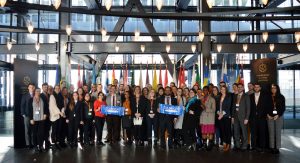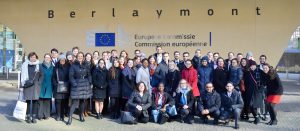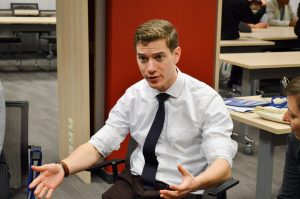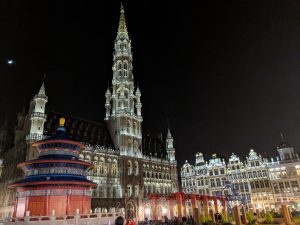Benjamin Fait is a Fulbright researcher in Biological Sciences, Universidad Pompeu Fabra.
 Last week I arrived in Luxembourg intent on learning about the European Union and NATO. I was part of a seminar hosted by the Belgian Fulbright commission that was scheduled to visit the European Court of Justice, the European Commission, and NATO headquarters, along with visits to the United States Embassy in Luxembourg, the United States mission to the European Union, and the Bastogne War Museum. As you might expect, the other Fulbright researchers and students drawn to this sort of trip there were of a similar ilk as myself. While we came from different fields, some working in the sciences, some in policy, some in teaching, we were all the sorts of people whose heart skips a beat at a well-organized three-ring binder – who had strong opinions about how exactly that binder should be organized. We were all nerds, suddenly and abruptly thrust into an environment where it was socially acceptable to be passionate about flow charts. A herd, if you will. And as a herd, we were shepherded by Erica and Elizabeth, two meticulous organizers of the seminars who performed the miracle of keeping 70 of us on schedule across several days and two countries.
Last week I arrived in Luxembourg intent on learning about the European Union and NATO. I was part of a seminar hosted by the Belgian Fulbright commission that was scheduled to visit the European Court of Justice, the European Commission, and NATO headquarters, along with visits to the United States Embassy in Luxembourg, the United States mission to the European Union, and the Bastogne War Museum. As you might expect, the other Fulbright researchers and students drawn to this sort of trip there were of a similar ilk as myself. While we came from different fields, some working in the sciences, some in policy, some in teaching, we were all the sorts of people whose heart skips a beat at a well-organized three-ring binder – who had strong opinions about how exactly that binder should be organized. We were all nerds, suddenly and abruptly thrust into an environment where it was socially acceptable to be passionate about flow charts. A herd, if you will. And as a herd, we were shepherded by Erica and Elizabeth, two meticulous organizers of the seminars who performed the miracle of keeping 70 of us on schedule across several days and two countries.

The ethos of bookishness I saw in the group was well-suited to the task at hand. One way of looking at the European Union and NATO is as a set of giant recursive flowcharts – governments of governments arranged in dizzyingly complex ways to boil down various international interests into some sort of mutual benefit. The sheer complexity of the European Union and NATO made visiting them in person all the more valuable. For example, seeing a case in the European Court of Justice helped me see how the conflicts that the European Union’s court system resolves are not dissimilar to the conflicts that arise in the Supreme Court of the United States about the distribution of power between state and federal governments. Visiting these places in person took the dry, abstract knowledge and gave me analogues from my own experience to help that information become more functional and intuitive.
 Beyond this, physically entering a place has a psychological effect. Just as students who visit a university are much more likely to apply for college, seeing international governance in the flesh made participating in this system seem like something that was a possibility. I knew that the European Union offered support for trans-Atlantic collaboration and exchange of students. However, for whatever reason, having been to the European Commission and heard of the programs from the source they are now something I actively picture myself using or guiding others to in the future. Specifically, knowing that fellowships like the Marie Skłodowska-Curie fellowship exists to help foster trans-Atlantic scientific collaboration, I find myself thinking more and more about how my now colleagues might one day be collaborators.
Beyond this, physically entering a place has a psychological effect. Just as students who visit a university are much more likely to apply for college, seeing international governance in the flesh made participating in this system seem like something that was a possibility. I knew that the European Union offered support for trans-Atlantic collaboration and exchange of students. However, for whatever reason, having been to the European Commission and heard of the programs from the source they are now something I actively picture myself using or guiding others to in the future. Specifically, knowing that fellowships like the Marie Skłodowska-Curie fellowship exists to help foster trans-Atlantic scientific collaboration, I find myself thinking more and more about how my now colleagues might one day be collaborators.
Like scientific research, international exchange is a long-term investment – while in principle it’s easy to articulate how exchange of ideas and people can influence both countries for the better, it was immensely encouraging to hear lectures from individuals like Koen Lenaerts. Dr. Lenaerts, the President of the European Union, received a Fulbright to study at Harvard Law School alongside future U.S. Supreme Court justices. There, he explained to us, he nurtured a comparative perspective on constitutional law in the United States that directly shapes his work today.
 The seminar also encouraged thought and conversation among the participants about what NATO and the European Union are and what role they play in the future. As we witness a popular backlash against real and perceived elitism in the United States, I grow worried that the in less advantaged parts of the European Union, isolated by barriers of class and the additional barrier of language attainment to participate in government, there will be pockets of citizens in the who feel they are not represented; however, balancing this concern, it was reassuring to meet such dedicated and intelligent individuals working at the European Union and NATO. As a US citizen still relatively unfamiliar with international institutions, it gave me much more confidence in an international and collaborative future – a future resplendent with flowcharts and overflowing with binders.
The seminar also encouraged thought and conversation among the participants about what NATO and the European Union are and what role they play in the future. As we witness a popular backlash against real and perceived elitism in the United States, I grow worried that the in less advantaged parts of the European Union, isolated by barriers of class and the additional barrier of language attainment to participate in government, there will be pockets of citizens in the who feel they are not represented; however, balancing this concern, it was reassuring to meet such dedicated and intelligent individuals working at the European Union and NATO. As a US citizen still relatively unfamiliar with international institutions, it gave me much more confidence in an international and collaborative future – a future resplendent with flowcharts and overflowing with binders.